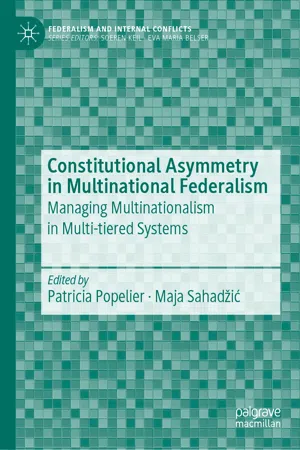
Constitutional Asymmetry in Multinational Federalism
Managing Multinationalism in Multi-tiered Systems
- English
- ePUB (mobile friendly)
- Available on iOS & Android
Constitutional Asymmetry in Multinational Federalism
Managing Multinationalism in Multi-tiered Systems
About this book
This edited volume examines the link between constitutional asymmetry and multinationalism in multi-tiered systems through a comprehensive and rigorous comparative analysis, covering countries in Europe, Africa and Asia. Constitutional asymmetry means that the component units of a federation do not have equal relationships with each other and with the federal authority. In traditional federal theories, this is considered an anomaly. The degree of symmetry and asymmetry is seen as an indicator of the degree of harmony or conflict within each system. Therefore symmetrisation processes tend to be encouraged to secure the stability of the political system. However, scholars have linked asymmetry with multinational federalism, presenting federalism and asymmetry as forms of ethnical conflict management. This book offers insights into the different types of constitutional asymmetry, the factors that stimulate symmetrisation and asymmetrisation processes, and the ways in which constitutionalasymmetry is linked with multinationalism.
Frequently asked questions
- Essential is ideal for learners and professionals who enjoy exploring a wide range of subjects. Access the Essential Library with 800,000+ trusted titles and best-sellers across business, personal growth, and the humanities. Includes unlimited reading time and Standard Read Aloud voice.
- Complete: Perfect for advanced learners and researchers needing full, unrestricted access. Unlock 1.4M+ books across hundreds of subjects, including academic and specialized titles. The Complete Plan also includes advanced features like Premium Read Aloud and Research Assistant.
Please note we cannot support devices running on iOS 13 and Android 7 or earlier. Learn more about using the app.
Information
1. Linking Constitutional Asymmetry with Multinationalism. An Attempt to Crack the Code in Five Hypotheses
Table of contents
- Cover
- Front Matter
- 1. Linking Constitutional Asymmetry with Multinationalism. An Attempt to Crack the Code in Five Hypotheses
- 2. Asymmetry and Complexity as a Device for Multinational Conflict Management. A Country Study of Constitutional Asymmetry in Belgium
- 3. Mild Asymmetry and Ethnoterritorial Overlap in Charge of the Consequences of Multinationalism. A Country Study of Constitutional Asymmetry in Bosnia and Herzegovina
- 4. Constitutional and Non-constitutional Asymmetries in the Canada Federation: An Exploration into the Policy Fields of Immigration and Manpower Training. A Country Study on Constitutional Asymmetry in Canada
- 5. Constitutional Asymmetry in the People’s Republic of China: Struggles for Autonomy Under a Communist Party-State. A Country Study of Constitutional Asymmetry in China
- 6. Federation Among Unequals. A Country Study of Constitutional Asymmetry in Ethiopia
- 7. Asymmetry as a Way to Move Forward with Multi-tiered Integration? A Study of Constitutional Asymmetry in the European Union
- 8. Accommodating Diversity, Consolidating Nationhood. A Country Study of Constitutional Asymmetry in India
- 9. Provincial Asymmetry in Indonesia: What Is so ‘Special’ About It? A Country Study of Constitutional Asymmetry in Indonesia
- 10. Federalism and Decentralisation in Iraq. A Country Study of Constitutional Asymmetry in Iraq
- 11. Irreversibly Different. A Country Study of Constitutional Asymmetry in Italy
- 12. Constitutional Asymmetry in Malaysia: A Case Study of Sabah and Sarawak. A Country Study of Constitutional Asymmetry in Malaysia
- 13. Asymmetry or Equality? Ethnic Nationalities in a Bamar-Dominated State. A Country Study of Constitutional Asymmetry in Myanmar
- 14. Subnational Empowerment for a Cohesive Federation. A Country Study of Constitutional Asymmetry in Pakistan
- 15. Constitutional Asymmetry in Russia: Issues and Developments. A Country Study of Constitutional Asymmetry in the Russian Federation
- 16. Asymmetry as a Device for Equal Recognition and Reasonable Accommodation of Majority and Minority Nations. A Country Study on Constitutional Asymmetry in Spain
- 17. Work in Progress. A Country Study of Constitutional Asymmetry in the United Kingdom
- 18. Conclusion. A Country Studies-Based Deliberation on Constitutional Asymmetry in Multi-tiered Multinational Systems
- Back Matter